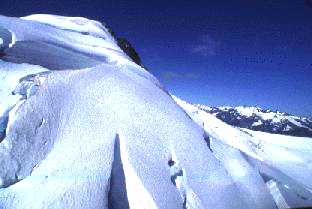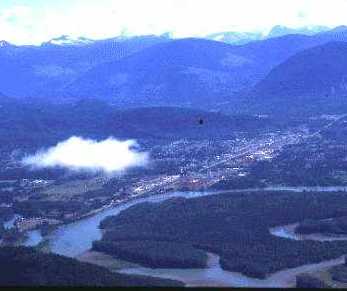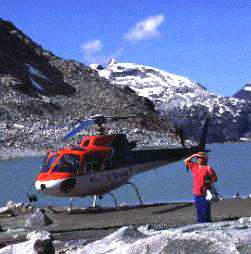BRITISH COLUMBIA HELI-HIKING
by John BeathFar above Skeena River civilization, an entire eco-system of mountains, lakes, wildflowers, and living glaciers remain unseen and untraveled -- except by heli-hikers, heli-glacier hoppers and mountain goats. Skeena Country visitors previously viewed the area Kodak style from a distance or they risked traveling for days over extremely rough terrain. Either way the rugged mountains quickly left them breathless.

Heli view of a Coast Range Glacier.
Photo credit: John Beath
Visiting anglers no longer have to risk life and limb to reach the cool white embrace of the Coast Mountain Range above the Skeena River. Now, mountain lovers of all ages and skill levels can enjoy half day, full day or overnight trips into the wilderness without the dangerous hassle of traversing miles of rocky snow-covered spires to reach the area of their choice.
Tours vary according to individual or group needs. A typical full day heli-hike begins at 10:00 am. Hikers load packs, either their own, or packs provided by the tour company, and prepare for the most awe-inspiring flight of a lifetime.
From the moment the helicopter springs skyward like a hawk, heli-hikers enjoy the oncoming view until the view surrounds the helicopter from below, above and to the sides. During the flight, it's easy to view the fertile Skeena valley and its many winding tributaries.
The steep spires of the Coast Mountain Range rise and fall at will as far as the naked eye can see. The view looks close enough to touch. Gravel colored peaks with tattered snowy blankets contrast the blue sky as the chopper flies farther into the wilderness reaches of the mountains. Each time the helicopter speeds past a hanging glacier, clues to past seasons and climates are revealed as clearly as rings in the core of a giant spruce.
Once a suitable meadow or ridge line is spotted, the helicopter circles like a bee heading for the sweet spot on a flower. Wildflowers flourish and add spectacular spots of color throughout the area.
When the helicopter lifts off, leaving the hikers and guide behind, the view dwarfs the craft as it heads off into the distance -- just like another bee amidst a field of flowers. When the noise of the chopper fades, another noise takes over. The mountains come alive as glaciers creak and groan from the strain of temperature and gravity. Falling rocks clanking downward and the sounds of glacial waterfalls echo throughout to create one of Mother Nature's best sensory symphonies.
By day's end, around 5:00 pm, the helicopter returns to whisk the heli-hikers back to civilization, where the beauty of the Coast Mountain Range is once again viewed from a distance or photos. And like the glaciers etched the mountains and valleys, they also etch memories into the minds of anglers and heli-hikers alike. After a visit to the Skeena Country and a heli-hike, the mountains will never look the same.

Skeena River through Terrace, BC provides easy access.
Photo credit: John Beath
Accessing wilderness areas in rugged terrain is safe and easy with the aid of a helicopter and experienced knowledgeable guide. Before the trip begins, hikers choose an easy downhill hike or more difficult uphill trek. Elevations vary from 4,000 to 7,000 feet. Most hikers choose the easy going downhill route. Meadows filled with wildflowers offer another easy hiking option. In an effort to keep the experience unique and wilderness oriented, Peak Experiences does not use trails and seldom goes to the exact same spot. Where you step might be the first and last time any human steps there.
What to bring
Heli-hikers should bring no more than 20 to 25 pounds of gear. Clothing should be layered and able to retain warmth in case of a sudden drop in temperature. A sturdy pair of comfortable hiking boots or shoes should be worn. Also bring an extra pair of socks.

Hiking below a Coast Range glacier's lake.
PHOTO CREDIT: JOHN BEATH
The sun's rays can burn skin or damage eyes when reflected off ice, snow or rock. As much as 90 percent of the sun's solar radiation is reflected upward by snow. Always wear sun glasses and a brimmed hat to protect your eyes. Apply sun block liberally on any exposed skin.
Bring water and food. Avoid any food that could spoil quickly. High protein, lightweight foods like trail mix make the best heli-hike snacks. Bring along juices as well, and remember to carry out any garbage. Don't forget the camera, video recorder, extra film and batteries. Shutterbugs instantly fall in love with the closeness that heli-hiking offers. A wide angle zoom lens in the 20 to 28-mm range and a zoom lens in the 80 to 200-mm range are two great choices.
Safety
Whether the hike is for a half day, full day or overnight excursion, the Peak Experiences' guides carry a radio to stay in contact with the helicopter and its base. They also carry first aid kits and other supplies that might be needed while in the embrace of the mountains.
Contacts: Peak Experiences {604} 632-7512 Rates vary.
